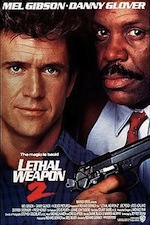 Trying to nail down just what this film is about is a pretty tricky proposition. Is it a documentary? A comedy? A commentary on modern attitudes about art? A critique of pop culture? The answer is yes, but with a rather large asterisk. Exit Through the Gift Shop is, ostensibly, a documentary about an aspiring filmmaker named Thierry Guetta who bumbles his way through life peddling overpriced clothing at his shop while also filming everything around him. Guetta takes a camera everywhere and fills bins upon bins with digital tape recordings of all the elements of his life. So far, so good–the documentary has a unique subject and a story to tell. Soon Guetta becomes fascinated with the world of street artists, and sets out to capture the underground world of graffiti art through the lens of his handycam. Again, things are going pretty well, especially as Guetta begins to form a relationship with Basksy, one of the most brilliant and infamous street artists in the world. But near the hour mark something strange happens–Banksy asks Guetta to show him the documentary he has been making (keep in mind the film we are watching is a documentary of a documentary…still with me? Good.) Guetta has piles of tapes and a passion for filming, but no clue how to actually edit and produce a film. So Banksy takes over, and turns the film into a new kind of documentary: he chronicles Guetta as he attempts to reinvent himself as Mr. Brainwash, legitimate street artist.
Trying to nail down just what this film is about is a pretty tricky proposition. Is it a documentary? A comedy? A commentary on modern attitudes about art? A critique of pop culture? The answer is yes, but with a rather large asterisk. Exit Through the Gift Shop is, ostensibly, a documentary about an aspiring filmmaker named Thierry Guetta who bumbles his way through life peddling overpriced clothing at his shop while also filming everything around him. Guetta takes a camera everywhere and fills bins upon bins with digital tape recordings of all the elements of his life. So far, so good–the documentary has a unique subject and a story to tell. Soon Guetta becomes fascinated with the world of street artists, and sets out to capture the underground world of graffiti art through the lens of his handycam. Again, things are going pretty well, especially as Guetta begins to form a relationship with Basksy, one of the most brilliant and infamous street artists in the world. But near the hour mark something strange happens–Banksy asks Guetta to show him the documentary he has been making (keep in mind the film we are watching is a documentary of a documentary…still with me? Good.) Guetta has piles of tapes and a passion for filming, but no clue how to actually edit and produce a film. So Banksy takes over, and turns the film into a new kind of documentary: he chronicles Guetta as he attempts to reinvent himself as Mr. Brainwash, legitimate street artist.
And reinvent himself he most certainly does, with a blowout first show that attracts thousands of visitors over the course of its five week run in Los Angeles. The catch? Guetta isn’t really an artist. He’s not really a filmmaker either. He’s…well, he’s a frenchman with extraordinary sideburns who repackages the work of true artists with a team of Photoshop wizards and down-on-their-luck sculptors. Just don’t tell that to the haute coutre crowd, the art world elite whose party Guetta crashed with a building full of poorly-conceived paintings and misshapen sculptures masquerading as modern art. The crowd who now happily shells out tens of thousands of dollars for Mr. Brainwash originals. The crowd who includes such high-profile names as Madonna, whose Celebrations album cover is a Mr. Brainwash original.
The real twist, though, comes when the film is over and the credits roll, as you start to wonder what it is that you just witnessed. Would a guy like Guetta, who doesn’t strike me as someone who could properly cook a box of macaroni and cheese, really be able to pull off a full-scale art show with no artistic talent and no history as an artist? Would people around the world really be gullible enough to buy into the wares he was peddling? What is it that defines art? Or was the whole shebang just a ruse? A massive practical joke played on the critics, collectors, and purveyors of the art scene by Banksy himself? Certainly there are more questions than answers here, and the film does an outstanding job of challenging our conceptions of what constitutes art. Banksy himself remains a steadfast enigma, shrouded in guttural voiceovers and pixellated blurs throughout the film. His talent as an artist is undeniable, his methods legally questionable, and his vision unmatchable. His film, too, is eminently watchable and thoroughly enjoyable.
Rating: [Rating:4/5]


















